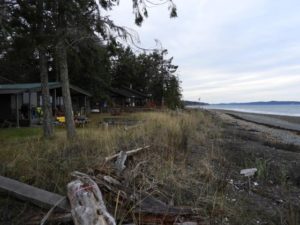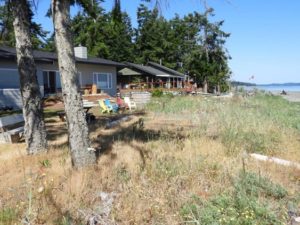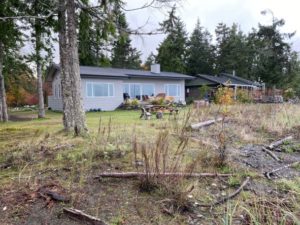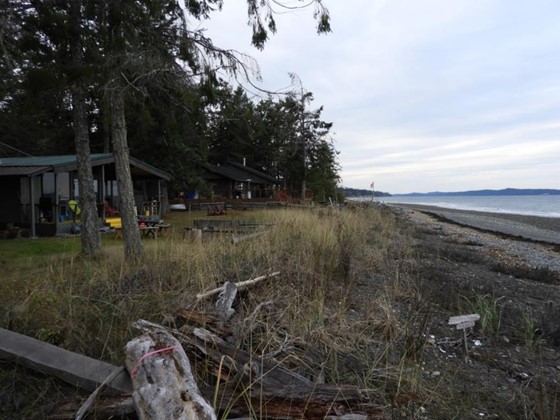
Before
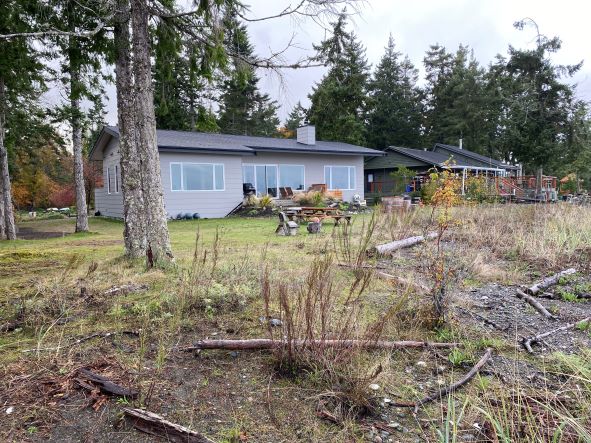
After
Project Overview
| Location: Qualicum Bay, BC | Project area: 0.32 ha |
| Year completed: 2018 | Awards: n/a |
| Shoreline length: 32 m | Shore type: Marine: gravel to cobble sized strata |
| Green Shores rating achieved: ORCA (Level 2) | Total points: 42 |
Site Description
This property included the former cabin with an outdated septic field and a firepit area. Some large established trees, riparian vegetation and large woody debris are present on site. The shoreline has a significant length of inter-tidal zone with a flat seabed that extends out to the Strait of Georgia. The low‑bank beach is gently sloped with gravel to cobble sized material. The cabin was replaced with a small house that was set 17 metres back from the ordinary high water mark and built to a ground floor elevation of 4.5 metres geodetic to meet anticipated sea level rise requirements.
Project Team and Affiliated Organizations
- Architect: Mark Ashby Architecture
- Biologist: Aquaparin Environmental Consulting
- Geotechnical Engineer: Simpson Geotechnical Ltd.
- Native Plant Supplier: Streamside Native Plants
Project Objectives
- Preserve and enhance natural foreshore with minimal intervention.
Work Plan
- This Green Shores for Homes® project preserved and enhanced the natural foreshore and did not include any hard shoreline protection measures. This was carried out through fencing of the riparian area during home construction, retention of existing large woody debris, and planting of additional native riparian vegetation. In addition, impervious surfaces were minimized and site disturbance was limited to the previously developed footprint outside of the riparian zone.
Description of how the project meets Green Shores principles
> Maintained/ Enhanced Habitat Function and Diversity
- Retained large woody material, creating habitat and microsites for plant establishment. This was in keeping with the natural conditions of the local shoreline and provided enhanced protection from potential erosion during high tides and storm events where wave action has been observed high up in the riparian area.
- Planted native vegetation to rehabilitate two areas that had sparse vegetation due to historical foot traffic. Planting with native species of vegetation included Dune Grass; complementing the Silver Beachweed and Gumweed on site.
> Preserved/Restored Shoreline Physical Processes
- Although there is a large wave fetch distance off the Strait of Georgia and the shoreline is exposed to strong wave energy during storm events, the owners have not observed the beach to be actively eroding. However, the owners have also observed that when a very high tide coincides with a storm event, waves run up into the riparian zone and very occasionally up the access path into the yard area. The enhanced riparian vegetation appears to be very important for dissipating the wave energy and for enhancing water infiltration. Waves do not travel as far and thus erosion is limited and flood protection is improved.
> Ecological Services Provided
- Almost the entire existing riparian buffer, which averaged slightly greater than 10 m in depth along the entire shoreline of the property, was preserved, and additional native vegetation was in-fill planted.
- This riparian zone provides habitat for small amphibians and insects. The retention of the existing large woody debris within the foreshore, along with large trees at the edge, promote ecological function. The reduced footprint of the new beach access also protects shoreline habitat values.
> Shoreline Collaboration and Public Education
- The property owners posted information about their Green Shores project on both Facebook and Twitter – two innovative uses of social media to advance understanding of a successful soft shore approach.
> Additional Notes
- Water quality objectives were met through minimizing the impervious surface area through use of a gravel driveway and parking area. This project also qualified for points for the approved landscape maintenance plan that specified no synthetic/inorganic pesticides, herbicides or fertilizers would be used in routine landscape management. The newly installed septic system also contributes to water quality objectives with updated design and functioning.
Photo Gallery
You can click on any photo to view it on full screen.


